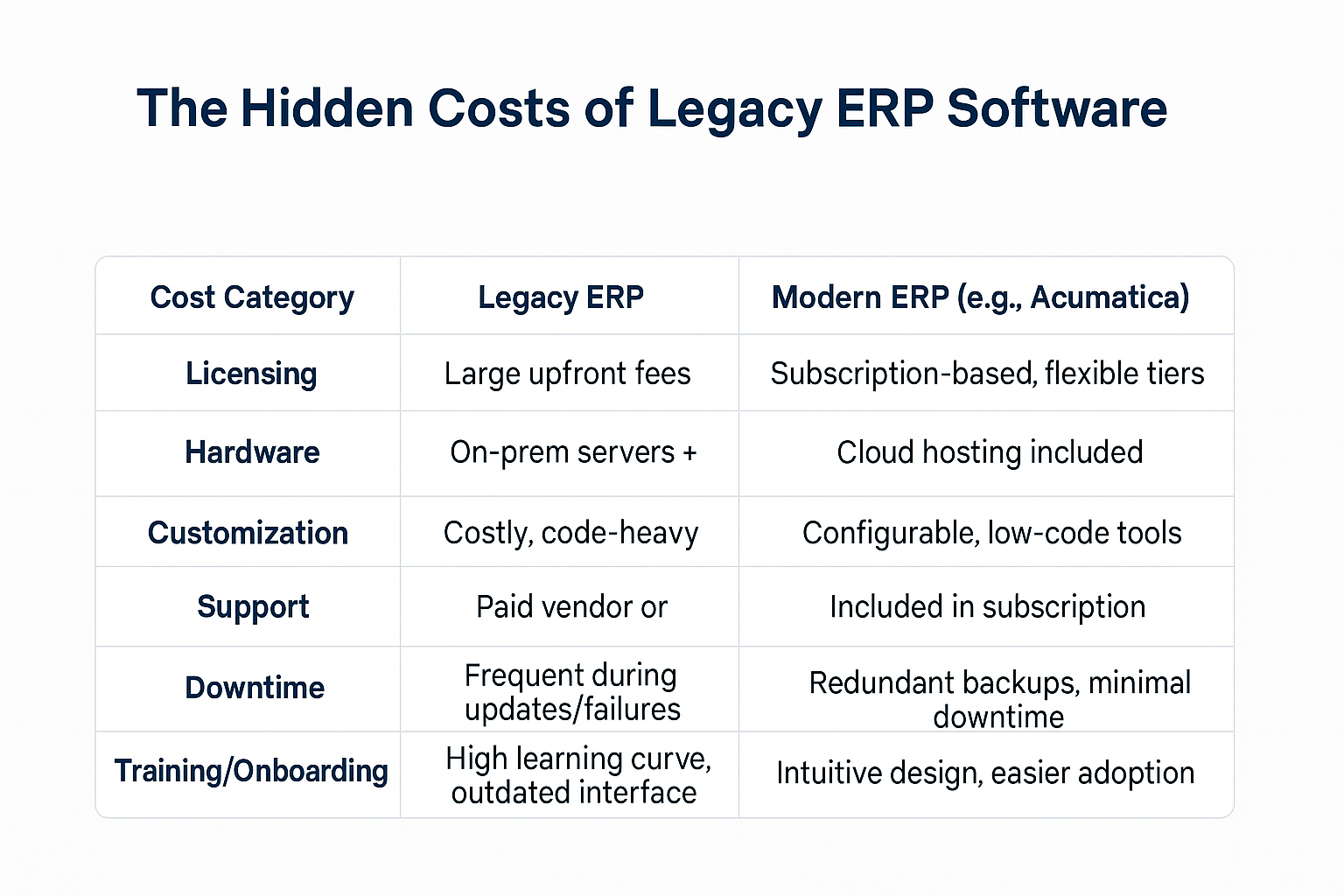The Real Cost of Using ERP Legacy Software
For construction and engineering firms, legacy ERP systems often feel like a known quantity. They're familiar, and they've been in place for years, maybe decades.
But the longer you rely on outdated tools, the more hidden costs start stacking up, and the more value you're leaving on the table.
Today’s cloud-based ERP systems like Acumatica are designed for flexibility, real-time access, and automation across field and office. If you’re still relying on legacy software, it might be time to take a closer look at the real costs involved.
What Is a Legacy ERP System?
In 2025, a legacy ERP system is any software that no longer meets your business needs or keeps up with modern expectations. It often:
- Runs on-premises (usually in a server room you’re still paying to maintain).
- Has an outdated or clunky interface.
- Can’t connect easily with newer tools or mobile apps.
- Requires heavy IT support just to keep running.
- Makes you depend on manual workarounds (like spreadsheets or paper).
Top signs your ERP is holding you back:
- You rely on Excel to fill reporting gaps.
- Your team can't access the system on mobile.
- Updates are slow, expensive, or non-existent.
- Integrations are limited or require custom work.
- Your vendor no longer supports the system.
The Hidden Costs of Legacy ERP Software
Legacy systems often seem cheaper at first, but they come with expensive surprises. Here’s how they stack up against modern cloud solutions like Acumatica:

These costs add up. From lost productivity to inflated IT expenses, maintaining a legacy ERP system can quickly outpace the cost of a modern upgrade.
How Much Does ERP Software Really Cost?
ERP costs vary depending on business size, complexity, and the vendor you choose. Here’s how it typically breaks down:
1. Licensing
- Legacy systems: Often a large one-time purchase (perpetual license).
- Modern ERP (like Acumatica): Subscription-based (SaaS), priced by resources used.
2. Implementation
- Legacy systems often require custom builds.
- Acumatica implementations are faster and more repeatable, especially with partners like ReviveERP to customize your rollout, train your team, and align the system with your workflows from day one.
3. Customization & Integration
- Legacy: Expensive and rigid.
- Modern: Low-code options make updates easy and scalable.
4. Training & Support
- Legacy: May require in-house IT teams or paid vendor hours.
- Modern: Support is usually bundled in the SaaS plan.
5. Maintenance & Upgrades
- Legacy: Costly and disruptive.
- Modern: Regular, automatic updates included.
How much does an ERP system cost?
For mid-size construction or engineering firms, modern ERP implementation typically ranges from $75,000–$150,000. Ongoing SaaS costs vary based on user count and features, but many ReviveERP clients find the ROI makes up for the cost within the first year.
ROI Clues to Watch For
If you’re still unsure if it’s time to switch, here are some signs your current ERP is costing more than it’s worth:
- Frequent delays or downtime during projects.
- Missed revenue from inaccurate change order tracking.
- High IT overhead.
- Poor visibility into project performance or margins.
The cost of doing nothing is real: outdated systems impact your bottom line, your efficiency, and your ability to scale.
When should I replace my ERP?
Replace your ERP when it starts costing you time, money, or visibility. If your team spends more time working around limitations than actually getting work done, the system is no longer serving you. Don’t wait for a full system failure, replace it when inefficiencies start holding you back from growth.
What is the ERP replacement cost?
ERP replacement costs vary depending on your current system, data complexity, user count, and desired functionality. But here’s the bigger picture: ignoring the problem often costs more. Delays, inefficiencies, inaccurate billing, and poor decision-making can quietly drain your profits over time. An investment in a modern system like Acumatica delivers measurable ROI in months, not years.
What Construction CFOs Should Budget For
A smart ERP upgrade plan includes:
- Software subscription (e.g., Acumatica tiers based on resources, not user seats).
- Implementation support (from a partner like ReviveERP).
- Internal training and rollout resources.
- Contingency for process improvements.
With Acumatica, many firms save time and money by eliminating manual work, speeding up billing, and improving cash flow visibility.
You should budget for implementation, cloud subscription, training, and internal rollout, and a trusted partner like ReviveERP can help you scope it right.
Real-World Advice from ERP Experts
ReviveERP has helped dozens of construction and engineering firms navigate the move from legacy systems to modern ERP like Acumatica. Here’s what we’ve learned:
- Clients underestimate support and downtime costs with legacy systems.
- Mobile access and automation create surprising ROI.
- Most firms break even on ERP upgrade costs within 12–18 months.
- You don't need a giant IT team, just the right partner.
ERP Is a Smart Investment
Replacing your legacy ERP system is a major decision, but it’s also one of the smartest moves you can make to protect your margins, improve forecasting, and future-proof your operations.
Let’s stop thinking about ERP as a sunk cost and start treating it like the strategic asset it is.
Ready to evaluate your legacy system? Talk to a ReviveERP consultant about what a modern ERP upgrade could look like for your firm.








